Nanoparticles Partially Restore Bacterial Susceptibility to Antibiotics
Abstract
1. Introduction
2. Materials and Methods
2.1. Sampling
2.2. Treatment Formulations
2.3. Isolation and Identification of S. epidermidis Bacteria
2.4. Efflux Effect and Antimicrobial Sensitivity Testing
2.5. Statistical Analyses
3. Results
3.1. The Number of Isolates of Bacteria
3.2. Change of Susceptibility to Antibiotics and Change of Isolate Contribution with Efflux Effect for S. epidermidis after Cow Treatment with the Antibiotic Drug and AgNPs
4. Discussion
4.1. Susceptibility Change
4.2. Change in the Percentage of Isolates with Efflux Effect
4.3. Change in the Number of Isolates of Four Bacteria after Treatments
4.4. Cow Recovery Period
4.5. New Approach to Reducing Bacterial Drug Resistance
5. Conclusions
Author Contributions
Funding
Institutional Review Board Statement
Data Availability Statement
Acknowledgments
Conflicts of Interest
References
- Samtiya, M.; Matthews, K.R.; Dhewa, T.; Puniya, A.K. Antimicrobial Resistance in the Food Chain: Trends, Mechanisms, Pathways, and Possible Regulation Strategies. Foods 2022, 11, 2966. [Google Scholar] [CrossRef] [PubMed]
- Murugaiyan, J.; Kumar, P.A.; Rao, G.S.; Iskandar, K.; Hawser, S.; Hays, J.P.; Mohsen, Y.; Adukkadukkam, S.; Awuah, W.A.; Jose, R.A.M.; et al. Progress in Alternative Strategies to Combat Antimicrobial Resistance: Focus on Antibiotics. Antibiotics 2022, 11, 200. [Google Scholar] [CrossRef] [PubMed]
- Gupta, R.; Sharma, S. Role of alternatives to antibiotics in mitigating the antimicrobial resistance crisis. Indian J. Med. Res. 2022, 156, 464–477. [Google Scholar] [CrossRef] [PubMed]
- Mateo, E.M.; Jiménez, M. Silver Nanoparticle-Based Therapy: Can It Be Useful to Combat Multi-Drug Resistant Bacteria? Antibiotics 2022, 11, 1205. [Google Scholar] [CrossRef] [PubMed]
- FAO. Available online: https://www.fao.org/dairy-production-products/production/dairy-animals/en/ (accessed on 26 May 2023).
- Cobirka, M.; Tancin, V.; Slama, P. Epidemiology and Classification of Mastitis. Animals 2020, 10, 2212. [Google Scholar] [CrossRef] [PubMed]
- Wells, S.J.; Ott, S.L.; Seitzinger, A.H. Key health issues for dairy cattle—New and old. J. Dairy Sci. 1998, 81, 3029–3035. [Google Scholar] [CrossRef] [PubMed]
- Wellenberg, G.J.; van der Poel, W.H.; Van Oirschot, J.T. Viral infections and bovine mastitis: A review. Vet. Microbiol. 2002, 88, 27–45. [Google Scholar] [CrossRef] [PubMed]
- Duse, A.; Persson-Waller, K.; Pedersen, K. Microbial Aetiology, Antibiotic Susceptibility and Pathogen-Specific Risk Factors for Udder Pathogens from Clinical Mastitis in Dairy Cows. Animals 2021, 11, 2113. [Google Scholar] [CrossRef] [PubMed]
- Nefedova, E.; Shkil, N.; Luna Vazquez-Gomez, R.; Garibo, D.; Pestryakov, A.; Bogdanchikova, N. AgNPs Targeting the Drug Resistance Problem of Staphylococcus aureus: Susceptibility to Antibiotics and Efflux Effect. Pharmaceutics 2022, 14, 763. [Google Scholar] [CrossRef] [PubMed]
- Garibo Ruiz, D.; Nefedova, E.; Shkil, N.N.; Shkil, N.A.; Vazquez-Gomez, R.L.; Pestryakov, A.; Bogdanchikova, N. Silver Nanoparticles Targeting the Drug Resistance Problem of Streptococcus dysgalactiae: Susceptibility to Antibiotics and Efflux Effect. Int. J. Mol. Sci. 2022, 23, 6024. [Google Scholar] [CrossRef] [PubMed]
- Nefedova, E.; Shkil, N.N.; Shkil, N.A.; Garibo, D.; Luna Vazquez-Gomez, R.; Pestryakov, A.; Bogdanchikova, N. Solution of the Drug Resistance Problem of Escherichia coli with Silver Nanoparticles: Efflux Effect and Susceptibility to 31 Antibiotics. Nanomaterials 2023, 13, 1088. [Google Scholar] [CrossRef] [PubMed]
- Plotnikov, E.V.; Tretayakova, M.S.; Garibo-Ruíz, D.; Rodríguez-Hernández, A.G.; Pestryakov, A.N.; Toledano-Magaña, Y.; Bogdanchikova, N. A Comparative Study of Cancer Cells Susceptibility to Silver Nanoparticles Produced by Electron Beam. Pharmaceutics 2023, 15, 962. [Google Scholar] [CrossRef] [PubMed]
- Buchanan, R.E.; Gibbons, N.E. Bergey’s Manual of Determinative Bacteriology, 8th ed.; Williams & Wilkins: Baltimore, MD, USA, 1974; p. 1268. [Google Scholar]
- M2-A10; Performance Standard for Antimicrobial Disk Susceptibility Tests. CLSI: Wayne, PA, USA, 2009.
- Martins, M.; Viveiros, M.; Couto, I.; Costa, S.S.; Pacheco, T.; Fanning, S.; Pagès, J.M.; Amaral, L. Identification of efflux pump-mediated multidrug-resistant bacteria by the ethidium bromide-agar cartwheel method. In Vivo 2011, 25, 171–178. [Google Scholar] [PubMed]
- Bogdanchikova, N.; Maklakova, M.; Villarreal-Gómez, L.J.; Nefedova, E.; Shkil, N.N.; Plotnikov, E.; Pestryakov, A. Revealing the Second and the Third Causes of AgNPs Property to Restore the Bacterial Susceptibility to Antibiotics. Int. J. Mol. Sci. 2023, 24, 7854. [Google Scholar] [CrossRef] [PubMed]
- Adeniji, O.O.; Nontongana, N.; Okoh, J.C.; Okoh, A.I. The Potential of Antibiotics and Nanomaterial Combinations as Therapeutic Strategies in the Management of Multidrug-Resistant Infections: A Review. Int. J. Mol. Sci. 2022, 23, 15038. [Google Scholar] [CrossRef] [PubMed]
- Gao, X.; Ashok, J.; Kawi, S. A review on roles of pretreatment atmospheres for the preparation of efficient Ni-based catalysts. Catal. Today 2022, 397–399, 581–591. [Google Scholar] [CrossRef]
- The Drug Pyridostigmine Bromide. Just What Is It and What Does It Do? Available online: https://gulflink.health.mil/news/na_pb15may.htm (accessed on 26 July 2023).
- Schreiber, C.A.; Creinin, M.D.; Atrio, J.; Sonalkar, S.; Ratcliffe, S.J.; Barnhart, K.T. Mifepristone Pretreatment for the Medical Management of Early Pregnancy Loss. N. Engl. J. Med. 2018, 378, 2161–2170. [Google Scholar] [CrossRef] [PubMed]
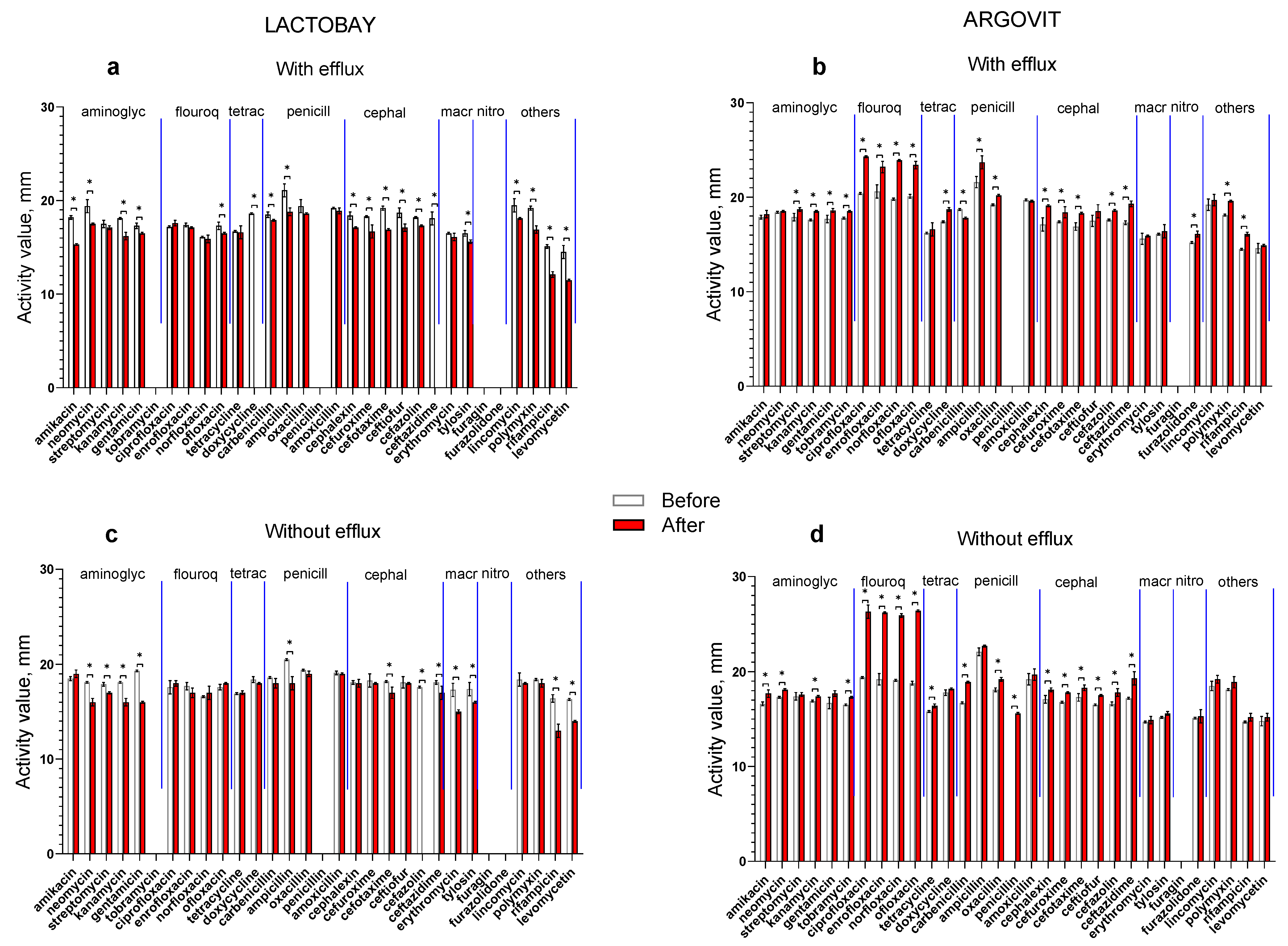
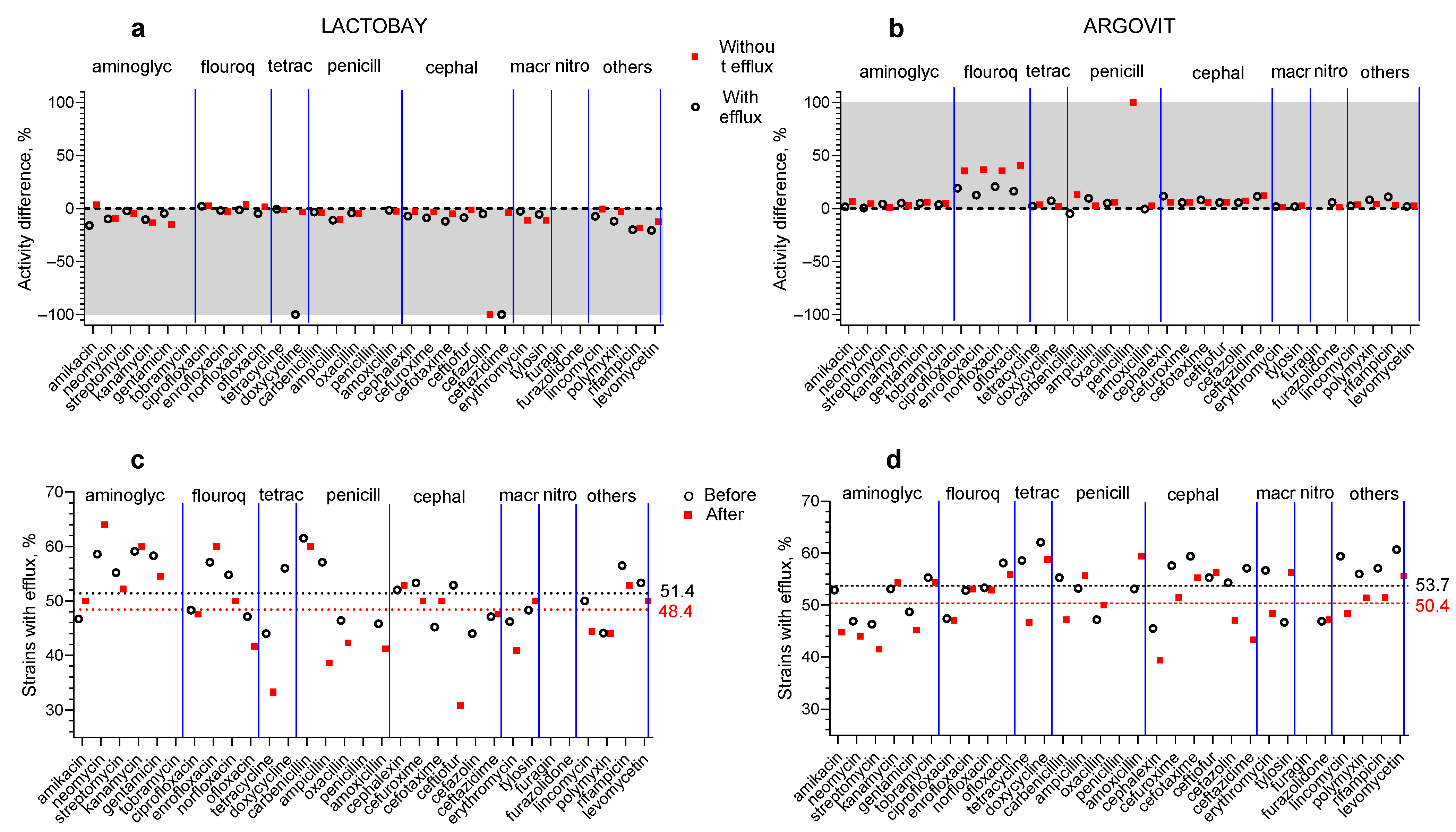
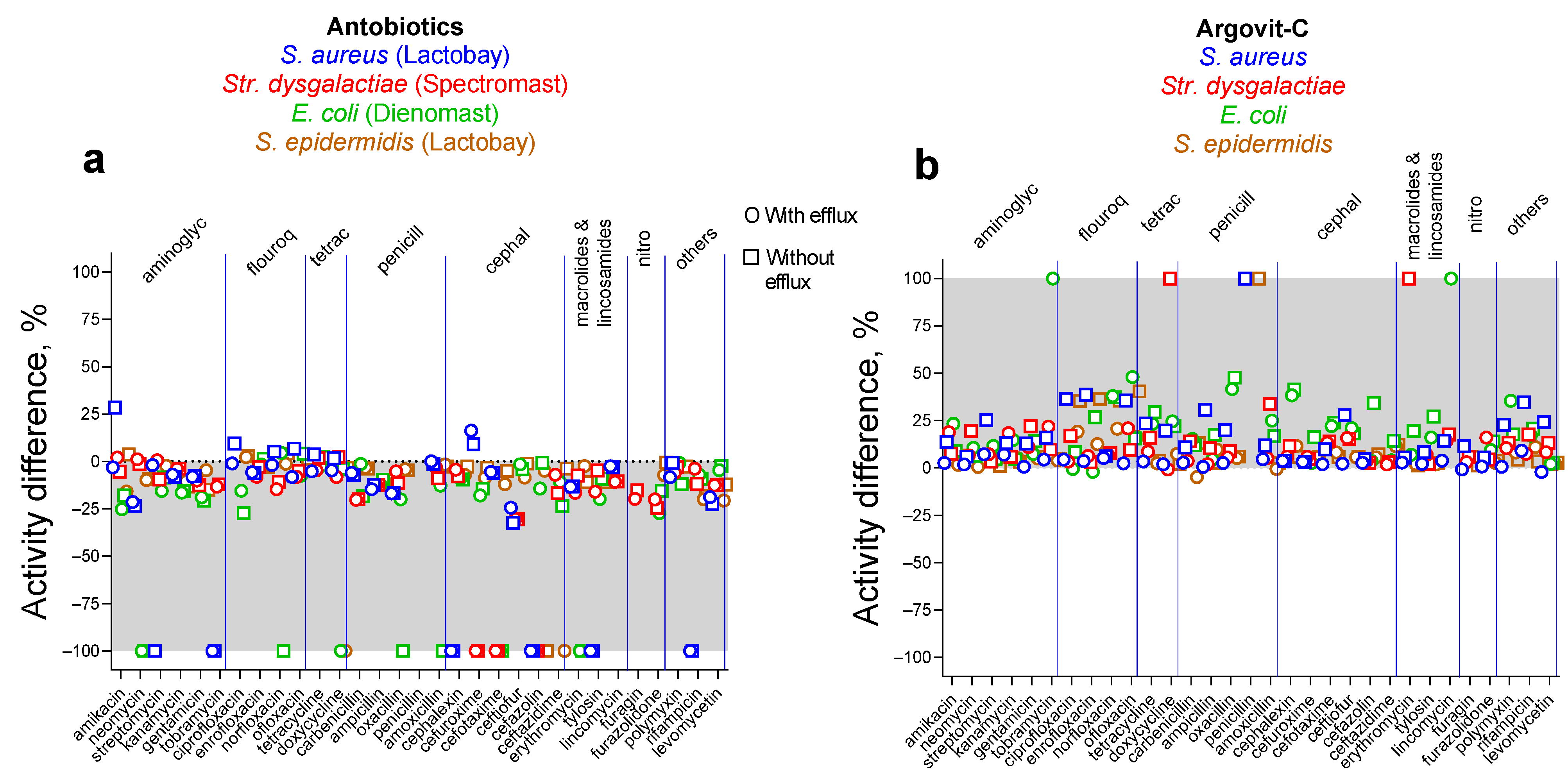
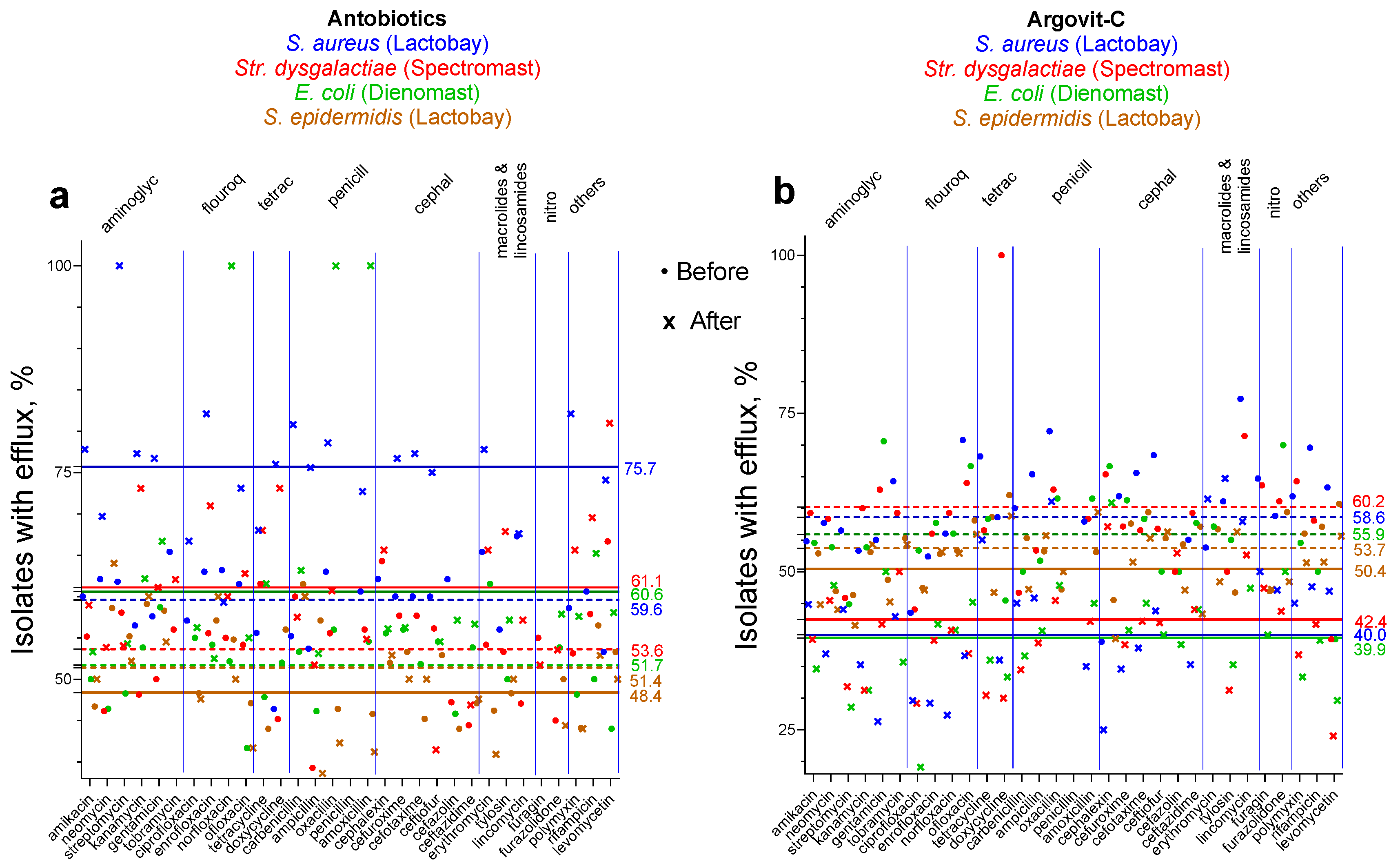
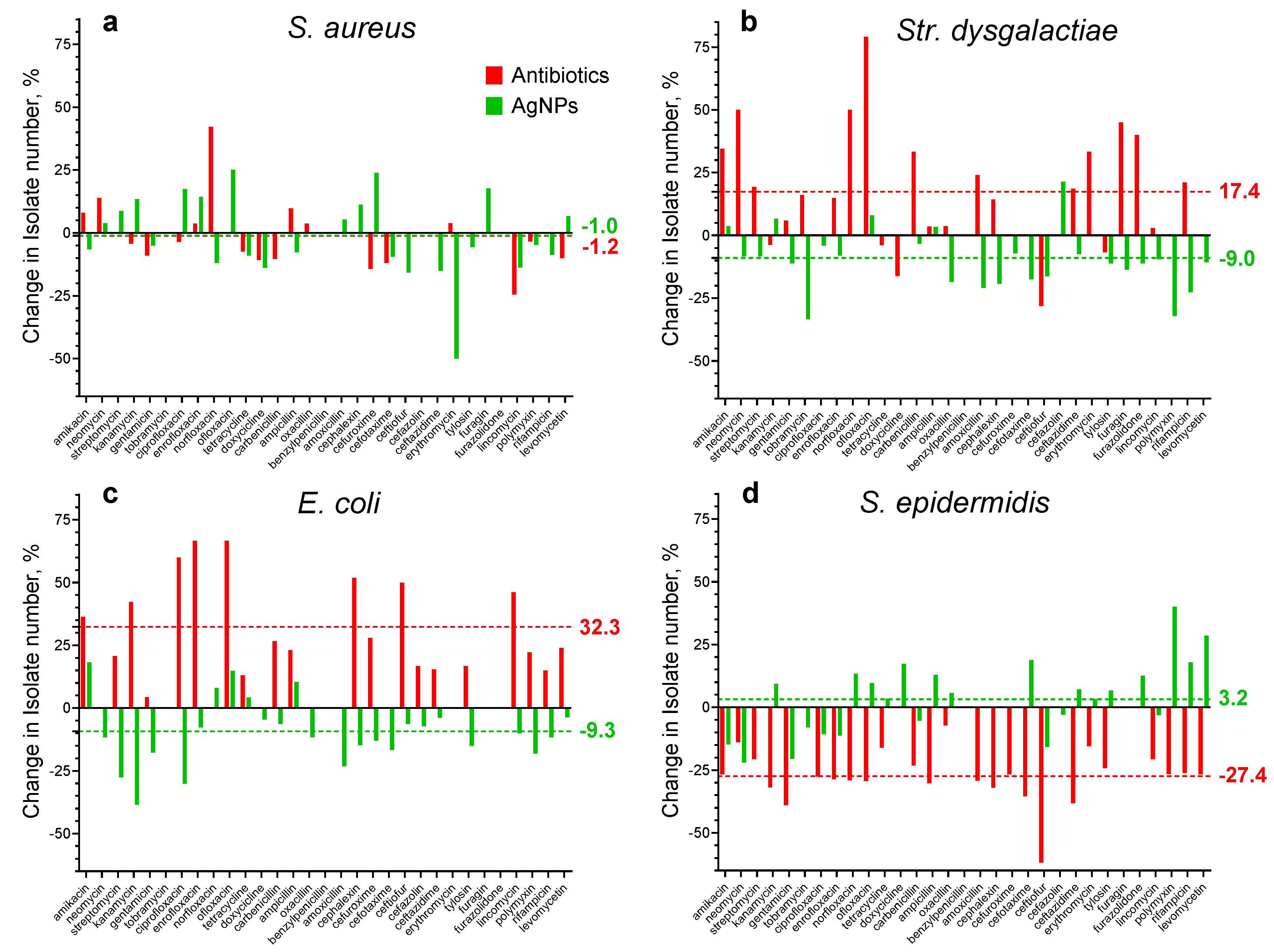
| Bacteria | The Number and Percent of Isolates of Six Bacteria Measured in Four Studies of Our Group | |||
|---|---|---|---|---|
| S. aureus Study, 400 Cows [1] | Str. dysgalactiae Study, 300 Cows [2] | E. coli Study, 200 Cows [3] | S. epidermidis Study, 220 Cows (Present Work) | |
| Str. dysgalactiae | 49.5 (12.4%) | 86.6 (28.9%) | 43 (21.5%) | 30.9 (14.1%) |
| S. aureus | 90 (22.5%) | 73.3 (24.4%) | 60 (30%) | 74.5 (33.9%) |
| Str. pyogenes | 40 (10%) | 50.0 (16.7%) | 32.5 (16.3%) | 36.4 (16.5%) |
| E. coli | 12.7 (3.2%) | 16.7 (5.6%) | 86.5 (43.3%) | 19.1 (8.7%) |
| S. epidermidis | 55 (13.8%) | 32 (10.7%) | 37 (18.5%) | 81.8 (37.2%) |
| Str. agalactiae | 45 (11.3%) | 26.7 (8.9%) | 33.5 (16.8%) | 28.6 (13.0%) |
| Bacteria | Isolates without Efflux Effect | Isolates with Efflux Effect | Isolates with Activity Change | |||
|---|---|---|---|---|---|---|
| Number of Antibiotics | Average Change in Susceptibility | Number of Antibiotics | Average Change in Susceptibility | Number of Antibiotics | Average Change in Susceptibility | |
| S. aureus | 27 | −25.8% | 27 | −24.5% | 54 | −25.1% |
| Str. dysgalactiae | 29 | −19.2% | 29 | −19.2% | 58 | −19.2% |
| E. coli | 27 | −30.2% | 27 | −24.4% | 54 | −27.3% |
| S. epidermidis | 27 | −8.50% | 27 | −14.0% | 54 | −11.3% |
| Bacteria | Isolates without Efflux Effect | Isolates with Efflux Effect | Isolates with Activity Change | |||
|---|---|---|---|---|---|---|
| Number of Antibiotics | Average Change in Susceptibility | Number of Antibiotics | Average Change in Susceptibility | Number of Antibiotics | Average Change in Susceptibility | |
| S. aureus | 30 | +19.9% | 29 | +2.9% | 59 | +11.4% |
| Str. dysgalactiae | 30 | +17.2% | 29 | +8.9% | 59 | +13.1% |
| E. coli | 29 | +19.4% | 29 | +22.9% | 58 | +21.2% |
| S. epidermidis | 30 | +12.3% | 29 | +6.60% | 59 | +9.5% |
| Bacteria | The Total Increase in Antibiotic Activity When AgNPs Are Used Instead of Antibiotic Drugs |
|---|---|
| S. aureus | 36.5% |
| Str. dysgalactiae | 32.3% |
| E. coli | 48.5% |
| S. epidermidis | 20.8% |
| Bacteria | Number of Isolates: Without Efflux/with Efflux for Each Case | |||||
|---|---|---|---|---|---|---|
| Activity Remains Absent | Activity Disappeared (−100%) | Activity Appeared (+100%) | Activity Decreased (−Δ%) | Activity Increased (+Δ%) | Activity Constant (Δ = 0%) | |
| S. aureus | 4/4 | 6/5 | 0/0 | 14/20 | 7/1 | 0/1 |
| Str. dysgalactiae | 2/2 | 3/3 | 0/0 | 24/23 | 2/3 | 0/0 |
| E. coli | 4/4 | 6/4 | 0/0 | 18/22 | 3/1 | 0/0 |
| S. epidermidis | 4/4 | 1/2 | 0/0 | 22/24 | 4/1 | 0/0 |
| Data for four bacteria | 14/14 | 16/14 | 0/0 | 78/89 | 16/6 | 0/1 |
| Data for isolates with and without efflux for four bacteria | 28 | 30 | 0 | 167 | 22 | 1 |
| Overall change | 23 positive changes * and 225 negative changes **, where positive changes represent 9.2% | |||||
| Bacteria | Number of Isolates: Without Efflux/With Efflux for Each Case | |||||
|---|---|---|---|---|---|---|
| Activity Remains Absent | Activity Disappeared (−100%) | Activity Appeared (+100%) | Activity Decreased (−Δ%) | Activity Increased (+Δ%) | Activity Constant (Δ = 0%) | |
| S. aureus | 1/2 | 0/0 | 1/0 | 0/2 | 29/27 | 0/0 |
| Str. dysgalactiae | 1/2 | 0/0 | 2/0 | 0/1 | 28/28 | 0/0 |
| E. coli | 2/2 | 0/0 | 2/2 | 0/2 | 27/25 | 0/0 |
| S. epidermidis | 1/2 | 0/0 | 1/0 | 0/2 | 29/27 | 0/0 |
| Data for four bacteria | 5/6 | 0/0 | 6/2 | 0/7 | 113/107 | 0/0 |
| Data for isolates with and without efflux for four bacteria | 11 | 0 | 8 | 7 | 220 | 0 |
| Overall change | 228 positive changes * and 18 negative changes **, where positive changes represent 92.7% | |||||
| Bacteria | Percentage of Isolates with Efflux Effect | The Increase in Antibiotic Activity When AgNP Treatment Is Used Instead of Antibiotic Treatment, % | |||||
|---|---|---|---|---|---|---|---|
| Antibiotic Treatment | AgNP Treatment | ||||||
| Before Treatment, % | After Treatment, % | Difference, % | Before Treatment, % | After Treatment, % | Difference, % | ||
| S. aureus | 59.6 | 75.7 | +16.1 | 58.6 | 40.0 | −18.6 | 34.7 |
| Str. dysgalactiae | 53.6 | 61.1 | +17.5 | 60.2 | 42.4 | −17.8 | 35.3 |
| E. coli | 51.7 | 60.6 | +8.9 | 55.9 | 39.9 | −16.0 | 24.9 |
| S. epidermidis | 51.4 | 48.4 | −3.0 | 53.7 | 50.4 | −3.3 | 0.3 |
| Bacteria | The Change in the Average Value of the Number of Isolates | Benefit from AgNP Treatment Compared to Antibiotic Drug Treatments, % | |
|---|---|---|---|
| After Antibiotic Treatment, % | After AgNP Treatment, % | ||
| S. aureus | −1.2 | −1.0 | −0.2 |
| Str. dysgalactiae | +17.4 | −9.0 | 26.4 |
| E. coli | +32.3 | −9.3 | 41.6 |
| S. epidermidis | −27.4 | +3.2 | −30.6 |
| Bacteria | Antibiotic Drug Name | Duration of Treatment with Antibiotic Drugs, Days | Duration of Treatment with AgNPs, Days | Acceleration of Treatment with AgNPs Compared to Antibiotic Treatment, % |
|---|---|---|---|---|
| S. aureus | Lactobay | 5.6 ± 0.4 | 4.1 ± 0.4 | 26.78 |
| Str. dysgalactiae | Spectromast | 4.8 ± 0.2 | 2.9 ± 0.1 | 39.58 |
| E. coli | Dienomast | 6.2 ± 0.2 | 3.2 ± 0.3 | 48.38 |
| S. epidermidis | Lactobay | 6.7 ± 0.2 | 4.9 ± 0.3 | 26.86 |
| Type of Advantage | Change Interval | Effectivity Order | Maximum Effectiveness | Minimum Effectiveness |
|---|---|---|---|---|
| Susceptibility increase | 20.8–48.5% | E. coli > S. aureus > Str. dysgalactiae > S. epidermidis | E. coli, 48.5% | S. epidermidis, 20.8% |
| Increase in the percentage of isolates without efflux effect | 0.3–35.3% | Str. dysgalactiae~S. aureus > E. coli > S. epidermidis | S. dysgalactiae ~ S. aureus, 35% | S. epidermidis, 0.3% |
| Decrease in bacteria isolate number | −30.6–+41.6% * | E. coli > Str. dysgalactiae > S aureus > S. epidermidis | E. coli, 41.6% | S. epidermidis, −30.6% * |
| Treatment duration decrease | 26.4–48.4% | E. coli > Str. dysgalactiae > S. epidermidis ~ S aureus E. coli > Str. dysgalactiae > S. epidermidis ~ S. aureus | E. coli, 48.4% | S. epidermidis and S. aureus, 26.4% |
Disclaimer/Publisher’s Note: The statements, opinions and data contained in all publications are solely those of the individual author(s) and contributor(s) and not of MDPI and/or the editor(s). MDPI and/or the editor(s) disclaim responsibility for any injury to people or property resulting from any ideas, methods, instructions or products referred to in the content. |
© 2024 by the authors. Licensee MDPI, Basel, Switzerland. This article is an open access article distributed under the terms and conditions of the Creative Commons Attribution (CC BY) license (https://creativecommons.org/licenses/by/4.0/).
Share and Cite
Bogdanchikova, N.; Luna Vazquez-Gomez, R.; Nefedova, E.; Garibo, D.; Pestryakov, A.; Plotnikov, E.; Shkil, N.N. Nanoparticles Partially Restore Bacterial Susceptibility to Antibiotics. Materials 2024, 17, 1629. https://doi.org/10.3390/ma17071629
Bogdanchikova N, Luna Vazquez-Gomez R, Nefedova E, Garibo D, Pestryakov A, Plotnikov E, Shkil NN. Nanoparticles Partially Restore Bacterial Susceptibility to Antibiotics. Materials. 2024; 17(7):1629. https://doi.org/10.3390/ma17071629
Chicago/Turabian StyleBogdanchikova, Nina, Roberto Luna Vazquez-Gomez, Ekaterina Nefedova, Diana Garibo, Alexey Pestryakov, Evgenii Plotnikov, and Nikolay N. Shkil. 2024. "Nanoparticles Partially Restore Bacterial Susceptibility to Antibiotics" Materials 17, no. 7: 1629. https://doi.org/10.3390/ma17071629
APA StyleBogdanchikova, N., Luna Vazquez-Gomez, R., Nefedova, E., Garibo, D., Pestryakov, A., Plotnikov, E., & Shkil, N. N. (2024). Nanoparticles Partially Restore Bacterial Susceptibility to Antibiotics. Materials, 17(7), 1629. https://doi.org/10.3390/ma17071629









